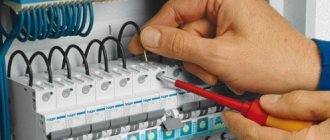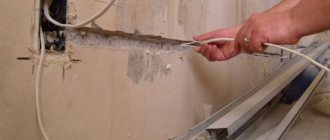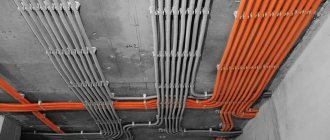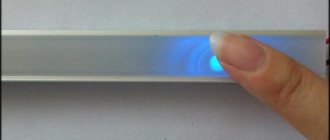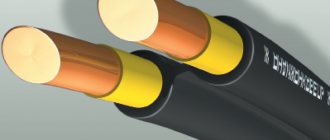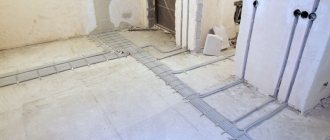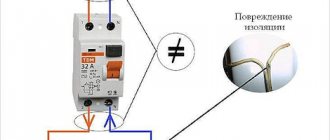For quite some time now, modern homes have stopped using corks. They were replaced by more technological devices - automatic machines, also known as baggers, although some still call them traffic jams, but this is wrong, because the operating principle of a traffic jam and a machine is somewhat different. Since in this article we will consider the selection of a machine depending on the cable cross-section, there will be no talk about traffic jams.
So, the machine is a device that allows you to open the electrical circuit automatically in two cases:
- line current overload;
- occurrence of a short circuit (SC).
In the first case, overload occurs due to a malfunction of electrical appliances or their large number and power density. In the second case, due to a short circuit, electricity is consumed to heat the wires with the maximum possible current for this section. In addition to the above cases of circuit breakage, the machine provides the possibility of manual control. There is a switch on the body of the device that allows you to open the circuit.
The purpose of the circuit breaker is to protect the section of the electrical circuit for which it is installed, as well as timely opening of this section in the event of an overload or short circuit.
Types of slot machines
Classification of circuit breakers occurs according to the following parameters:
- number of poles;
- rated and limit currents;
- the type of electromagnetic release used;
- maximum power switching capacity.
Let's look at it in order.
Number of poles
The number of poles is the number of phases that the machine is capable of protecting. Depending on the number of poles, machines can be:
- Single pole. Protection is provided for one output wire, one phase.
- Bipolar. As a rule, these are two combined single-pole circuit breakers with one common control knob. In a situation where the current of one of the machines exceeds the permitted load, both devices are switched off. Two-pole circuit breakers are used to completely disconnect the load (one phase), turning off the working phase and the working zero.
- Three-pole. They are used with three-phase circuits; if the load is exceeded, three phases are switched off simultaneously. Such machines also have one common circuit breaker.
- Four-pole. Similar to two-pole, but designed to work with three-phase circuits. When the load is exceeded, three phases and the working zero are opened simultaneously.
Rated and limiting currents
Everything is simple here - such a current strength at which the machine will open the circuit. At the rated current and even a little more than stated, work will be carried out, but only when the limit current is exceeded by 10–15% will a shutdown occur. This is due to the fact that quite often the starting currents exceed the maximum possible currents for a short period of time, so the machine has a certain reserve of time, after which the circuit will open.
Type of electromagnetic release
This is a part of the machine that allows you to open the circuit in the event of a short circuit, as well as in the event of an increase in current (overload) by a certain number of times. Releases are divided into several categories, let's look at the most popular:
- B - opening when the rated current is exceeded by 3–5 times;
- C - when exceeded by 5–10 times;
- D - when exceeded by 10–20 times.
Maximum power switching capacity. This is the value of the short circuit current (determined in thousands of amperes) at which the machine will remain operational after the circuit opens due to a short circuit.
Selection of the optimal cable cross-section
Each cable, like a machine, has a certain permitted load current. Depending on the cross-section and material of the cable, the load current also varies. To select a machine according to cable cross-section, use the table.
It should be noted that it is permissible to choose a cable with a small margin, but not a packet switch! The machine must match the planned load! In accordance with the rules for electrical installations 3.1.4, the setting currents of the circuit breakers should be selected that will be less than the calculated currents of the selected zones.
Let's look at an example: in a certain area, the electrical wiring is laid with a cable with a cross-section of 2.5 mm square, and the load is 12 kW, in this case, when installing a machine (at a minimum current) of 50 A, the wiring will ignite, since a wire with this cross-section is designed for an allowed current of 27 A, and much more passes through it. In this case, the circuit does not break, since the machine is adapted to these currents, but the wire is not; the automation will turn off the machine only in the event of a short circuit.
Neglecting this rule can lead to serious consequences!
Important! First, you should calculate the power of the consumers, and then select a conductor of the appropriate cross-section, and only after that select an automatic machine (packet). The rated current of the packet must be less than the maximum current allowed for the wire of this cross-section.
It is thanks to this principle that the wiring will never overheat and, therefore, no fire will occur.
Operating principle
The main element of the device is an electromagnetic and thermal release. The first guarantees protection against short circuits, the second - against overvoltage. An electromagnetic device is a coil with a core, which is placed on a special spring and, under normal conditions, creates an electromagnetic field that attracts the coil core. At the moment of a short circuit, the electric current increases and exceeds that nominally stated according to the technical characteristics. This current flows through the release coil and increases the field. As a result, the circuit is de-energized.
Operating principle of the machine
A circuit breaker is a device that ensures that all electrical equipment in the house and on the network operates properly. To calculate how many kilowatts a machine can withstand at 16, 32, 40 and 63 amperes, as well as see their power, just use the table above.
Calculation of consumer power
Each electrical network in an apartment or house can be divided into sections (rooms). Depending on what devices are planned to be used in a particular area, electrical wiring calculations are made. Typically, the electrical wiring zones for each machine are divided among themselves into each room of the apartment or house. One section of wiring for one room, the second for another, and the third for the kitchen and bathroom. In this situation, such powerful consumers as electric stoves, ovens, water heaters, and heating boilers stand apart. This technique requires a dedicated power line, so in modern homes designed for use with electric stoves, a separate circuit breaker is installed to provide power to the device.
Calculating the required current for a particular section of wiring is quite simple. To do this, use the formula I=P/U, according to which I is the current strength, P is the power (in watts) of all operating electrical appliances on this line, U is the network voltage (the standard is 220 volts). To calculate, you need to add up the power of those electrical appliances that you plan to use on the line, and then divide the resulting sum by 220. From here we get the current strength, according to which you will need to select a cable of a certain cross-section.
As an example, let’s take an area (room) and calculate for it a machine and a cable of the required cross-section. The following will work simultaneously in the room:
- vacuum cleaner (1300 W);
- electric iron (1000 W);
- air conditioning (1300 W);
- computer (300 W).
Let's add these indicators (1300+1000+1300+300 = 3900 W) and divide them by 220 (3900/220 = 17.72). It turns out that the current strength is 17.72, we select the optimal cable cross-section for this based on the table, take a copper cable with a cross-section of 2.5 mm or 4 mm square (be sure to take it with a reserve) and a circuit breaker with a rated protection current of 20 amperes.
It is worth mentioning that you should not choose a circuit breaker with an overestimated rated current, since if the electrical network is overloaded (exceeding the continuous-permissible current for a particular wire), the wiring will start to catch fire. The rating of the machine must correspond to the value of the continuous-permissible current of the conductor or be less.
Experienced electricians repeatedly say that you should not install cables with a small cross-section because they are cheap; you should choose a cable with a reserve to avoid overloading the electrical section and causing a fire in the wiring. But choosing a powerful machine gun is contraindicated!
The wiring is installed once, it is difficult to replace it, but replacing the switch in the event of a significantly increased load is much easier.
At the moment, more and more powerful electrical appliances are appearing, so it’s worth taking care in advance in case you decide to use a more powerful vacuum cleaner or add some additional device to the room.
Purpose
A 25 ampere circuit breaker is a device whose main task is to ensure the safety of the electrical network from overcurrent, that is, from a short circuit with overload. The main purpose of the device is to ensure the safety of the user himself when using the network and electrical appliances.
Such equipment is turned on and off from an electrical circuit. It is most often used to protect an electric stove or other kitchen heating appliances.
You may be interested in this: Learning to read electrical diagrams
Note! It can also be used to protect lighting system, motor, transformer and electronic appliance.
Electrical circuit protection as the main purpose
Nuances
In general, readers should not have any questions regarding the selection of packages according to the cable cross-section, but there are some subtleties that we did not mention above.
- A machine with which type of electromagnetic release to choose. In everyday life, machines of categories “B” and “C” are most often used. This is due to the fastest possible operation of package switches when the rated current is exceeded. This is extremely important when using appliances such as electric kettles, toasters and irons. Depending on the type of equipment used, you should choose a specific category; it is advisable to give preference to category “B” switches.
- A machine with a maximum switching capacity to choose. Depends on the location of the electricity input from the substation to the apartment, if in close proximity, then you should choose one with a switching capacity of 10,000 amperes, otherwise for city apartments there are enough devices for 5,000–6,000 amperes. You can play it safe and choose the option of 10,000 amperes; ultimately, this indicator only affects whether the machine will be operational after a short circuit.
- What type of wire to choose: aluminum or copper We strongly do not recommend purchasing aluminum conductors. Copper wiring is more durable and can handle higher currents.
What is tension? Volt [V]
Voltage is a physical quantity that characterizes the ratio of the work of the electric field in the process of transferring a charge from one point A to another point B to the value of this same charge. Simply put, it is the potential difference between two points. Measured in Volts.
The voltage is essentially similar to the amount of water pressure in the pipe; the higher it is, the faster the water flows from the tap. The voltage is standardized and the same for all apartments, houses and garages, equal to 220 Volts with single-phase power supply. Also allowed according to GOST is a 10 percent deviation for the home electrical network. The voltage must be no less than 198 and no more than 242 Volts.
1 Volt contains:
- 1,000,000 microvolts
- 1,000 millivolts
Industrial or homemade shield?
Nowadays different shields are sold. All kinds of shapes and sizes. They have either a primed metal, painted base or a plastic base. There are also brushes with internal factory filling. There are designs available for individual order.
But, if the shield installer has certain skills, then it is better to install the internal parts yourself, at your own discretion. The more experience, the more competently the installation of the structure in a certain volume of the electrical panel will be completed.
Weak link protection
So, we are convinced that the calculation of the circuit breaker should be made based not only on the total power of the devices included in the circuit (regardless of their number), but also on the cross-section of the wires. If this indicator is not the same along the electrical line, then we select the section with the smallest cross-section and calculate the machine based on this value.
The PUE requirements state that the selected circuit breaker must provide protection for the weakest section of the electrical circuit, or have a current rating that will correspond to a similar parameter for the installations connected to the network. This also means that the connection must be made using wires with a cross-section that can withstand the total power of the connected devices.
How to select the wire cross-section and rating of the circuit breaker - in the following video:
If a careless owner ignores this rule, then in the event of an emergency that arises due to insufficient protection of the weakest section of the wiring, he should not blame the selected device and scold the manufacturer - only he himself will be to blame for the current situation.
Location of the electrical panel in the room
It is important to decide on the installation location of the shield. Its location requires constant access; the switchboard door must not be blocked by foreign objects.
In most cases, the shield is mounted near the entrance to the house, or already inside, but immediately in the corridor of the house or apartment. This simplifies the installation of the cable supplying voltage to the room.
- The height of the shield is determined at the eye level of the residents of the home. This arrangement is necessary for the convenience of taking meter readings when paying for electricity.
- Previously, in not-so-distant times, meters with automatic machines were installed on a wooden plank on the wall.
- Although their location was usually under the ceiling, it is undesirable to do so. In the shield, the entire structure will be in a safer position.
Modern electrical panels have high protection classes, a good solid base, and a lock with a key. What is an obstacle for small household members to enter there.
In a private house, when placing the panel, the location of the high-voltage line from where the cable will be supplied to the room is taken into account.
Connection instructions
Before talking about the procedure for connecting a 16-amp machine, you should understand the main structural elements of the device. It consists of:
- Top contact clamp.
- Bottom terminal.
- Shift knobs.
- Electromagnetic release.
- Thermal (bimetallic) break contact.
How to understand the colors of wire cores Source markevich.by
Connection diagram of circuit breakers.
Before starting work on installing the machines, you need to familiarize yourself in detail with their schematic data. Different design elements in the shield have their own designations.
